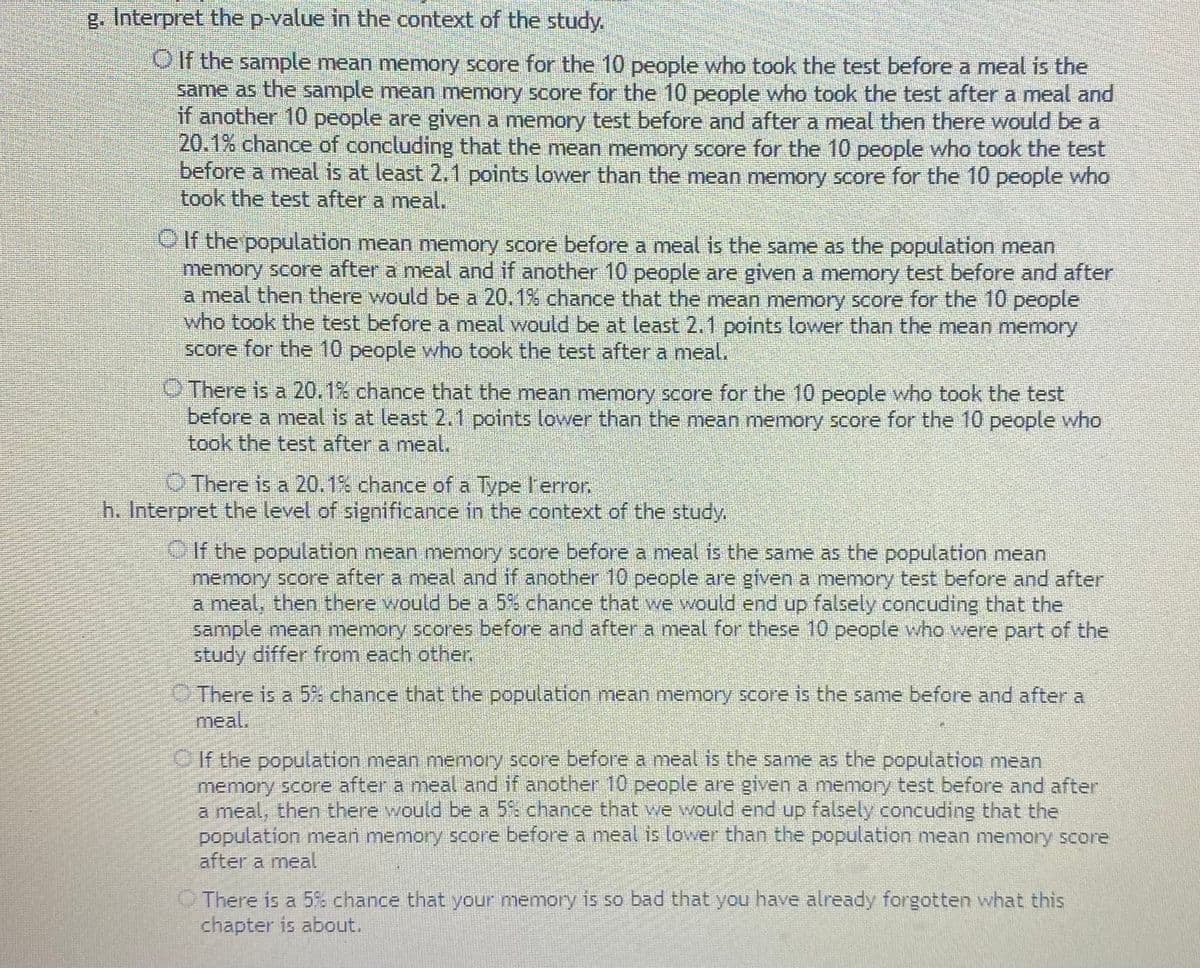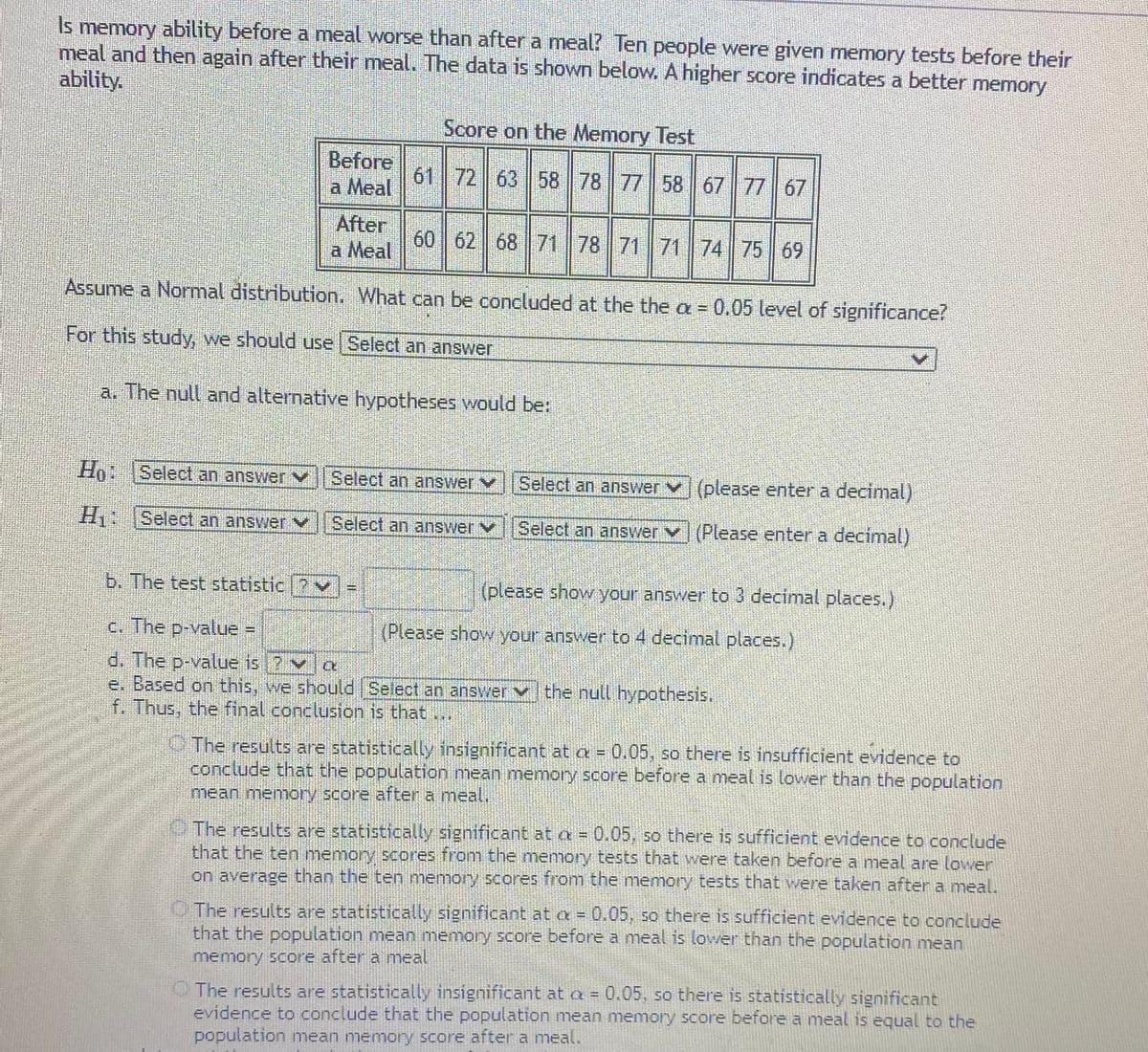Is memory ability before a meal worse than after a meal? Ten people were given memory tests before their meal and then again after their meal. The data is shown below. A higher score indicates a better memory ability. Score on the Memory Test Before 61 72 63 58 78 77 58 67 77 67 a Meal After 60 62 68 71 78 71 71 74 75 69 a Meal Assume a Normal distribution. What can be concluded at the the a 0.05 level of significance? For this study, we should use Select an answer
Is memory ability before a meal worse than after a meal? Ten people were given memory tests before their meal and then again after their meal. The data is shown below. A higher score indicates a better memory ability. Score on the Memory Test Before 61 72 63 58 78 77 58 67 77 67 a Meal After 60 62 68 71 78 71 71 74 75 69 a Meal Assume a Normal distribution. What can be concluded at the the a 0.05 level of significance? For this study, we should use Select an answer
Glencoe Algebra 1, Student Edition, 9780079039897, 0079039898, 2018
18th Edition
ISBN:9780079039897
Author:Carter
Publisher:Carter
Chapter10: Statistics
Section10.4: Distributions Of Data
Problem 19PFA
Related questions
Question

Transcribed Image Text:g. Interpret the p-value in the context of the study.
O If the sample mean memory score for the 10 people who took the test before a meal is the
same as the sample mean memory score for the 10 people who took the test after a meal and
if another 10 people are given a memory test before and after a meal then there would be a
20.1% chance of concluding that the mean memory score for the 10 people who took the test
before a meal is at least 2,1 points lower than the mean memory score for the 10 people who
took the test after a meal.
OIf the population mean memory score before a meal is the same as the population mean
memory score after a meal and if another 10 people are given a memory test before and after
a meal then there would be a 20.1% chance that the mean memory score for the 10 people
who took the test before a meal would be at least 2.1 points lower than the mean memory
score for the 10 people who took the test after a meal.
O There is a 20.1% chance that the mean memory score for the 10 people who took the test
before a meal is at least 2.1 points lower than the mean memory score for the 10 people who
took the test after a meal.
O There is a 20.1% chance of a Type l'error.
h. Interpret the level of significance in the context of the study,
If the population mean memory score before a meal is the same as the population mean
memory score after a meal and if another 10 people are given a memory test before and after
a meal, then there would be a 5% chance that we would end up falsely concuding that the
sample mean memory scores before and after a meal for these 10 people who were part of the
study differ from each other.
There is a 5% chance that the population mean memory score is the same before and after a
meal.
If the population mean memory score before a meal is the same as the population mean
memory score after a meal and if another 10 people are given a memory test before and after
a meal, then there would be a 5% chance that we would end up falsely concuding that the
population mean memory score before a meal is lower than the population mean memory score
after a meal
O There is a 5% chance that your memory is so bad that you have already forgotten what this
chapter is about.

Transcribed Image Text:Is memory ability before a meal worse than after a meal? Ten people were given memory tests before their
meal and then again after their meal. The data is shown below. A higher score indicates a better memory
ability.
Score on the Memory Test
Before
a Meal
61 72 63 58 78 77 58 67 77 67
After
a Meal
60 62 68 71 78 71 71 74 75 69
Assume a Normal distribution. What can be concluded at the the a = 0.05 level of significance?
For this study, we should use Select an answer
a. The null and alternative hypotheses would be:
Ho Select an answer
Select an answer v
Select an answer V(please enter a decimal)
H Select an answer V
Select an answer v
Select an answer v (Please enter a decimal)
b. The test statistic ?v
(please show your answer to 3 decimal places.)
c. The p-value =
(Please show your answer to 4 decimal places.)
d. The p-value is ? v
e. Based on this, we should Select an answer vthe null hypothesis.
f. Thus, the final conclusion is that .
O The results are statistically insignificant at a= 0.05, so there is insufficient evidence to
conclude that the population mean memory score before a meal is lower than the population
mean memory score after a meal,
The results are statistically significant at a= 0.05, so there is sufficient evidence to conclude
that the ten memory scores from the memory tests that were taken before a meal are lower
on average than the ten memory scores from the memory tests that were taken after a meal.
O The results are statistically significant at a = 0.05, so there is sufficient evidence to conclude
that the population mean memory score before a meal is lower than the population mean
memory score after a meal
O The results are statistically insignificant at a = 0.05, so there is statistically significant
evidence to conclude that the population mean memory score before a meal is equal to the
population mean memory score after a meal.
Expert Solution
This question has been solved!
Explore an expertly crafted, step-by-step solution for a thorough understanding of key concepts.
This is a popular solution!
Trending now
This is a popular solution!
Step by step
Solved in 3 steps with 3 images

Recommended textbooks for you

Glencoe Algebra 1, Student Edition, 9780079039897…
Algebra
ISBN:
9780079039897
Author:
Carter
Publisher:
McGraw Hill

Glencoe Algebra 1, Student Edition, 9780079039897…
Algebra
ISBN:
9780079039897
Author:
Carter
Publisher:
McGraw Hill